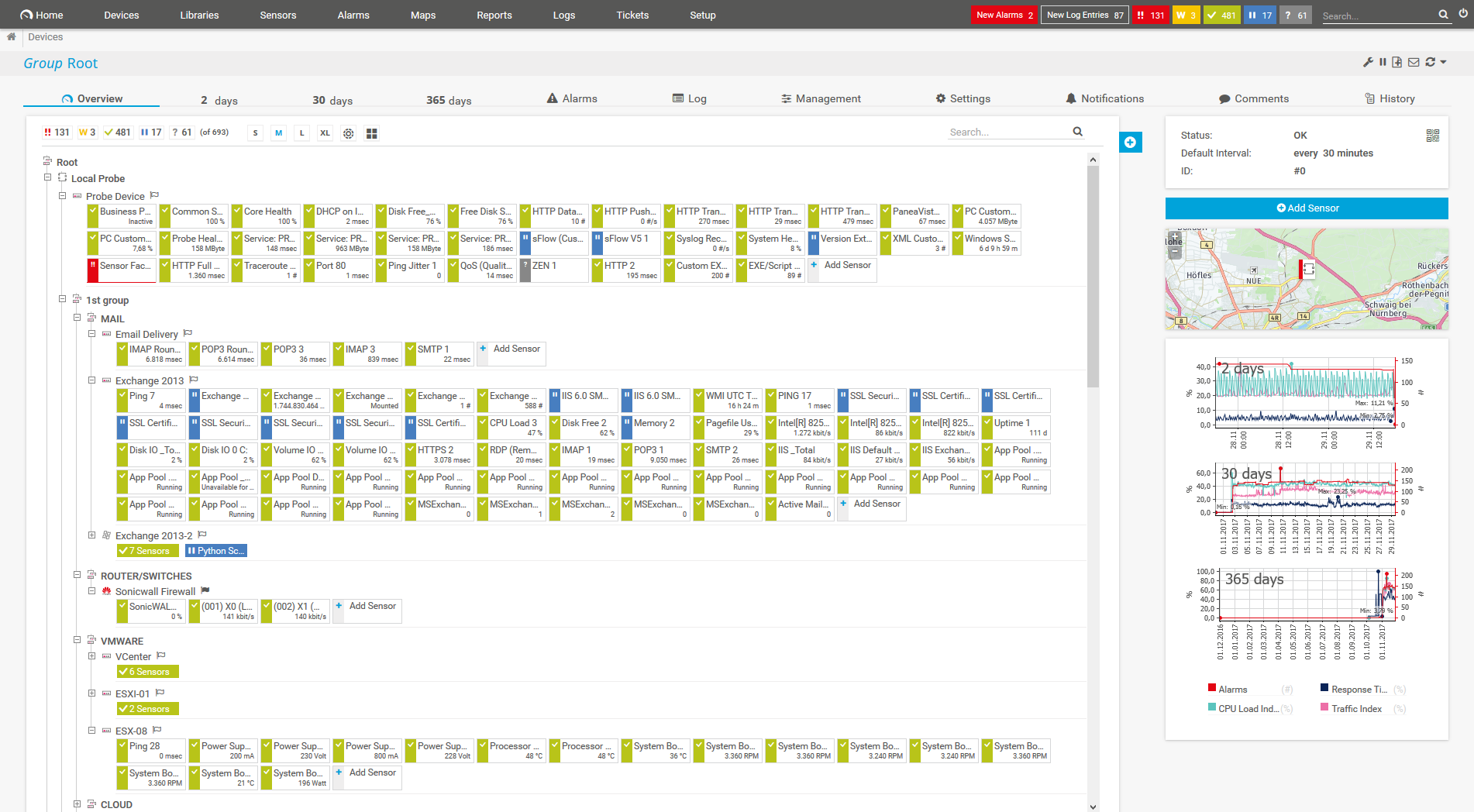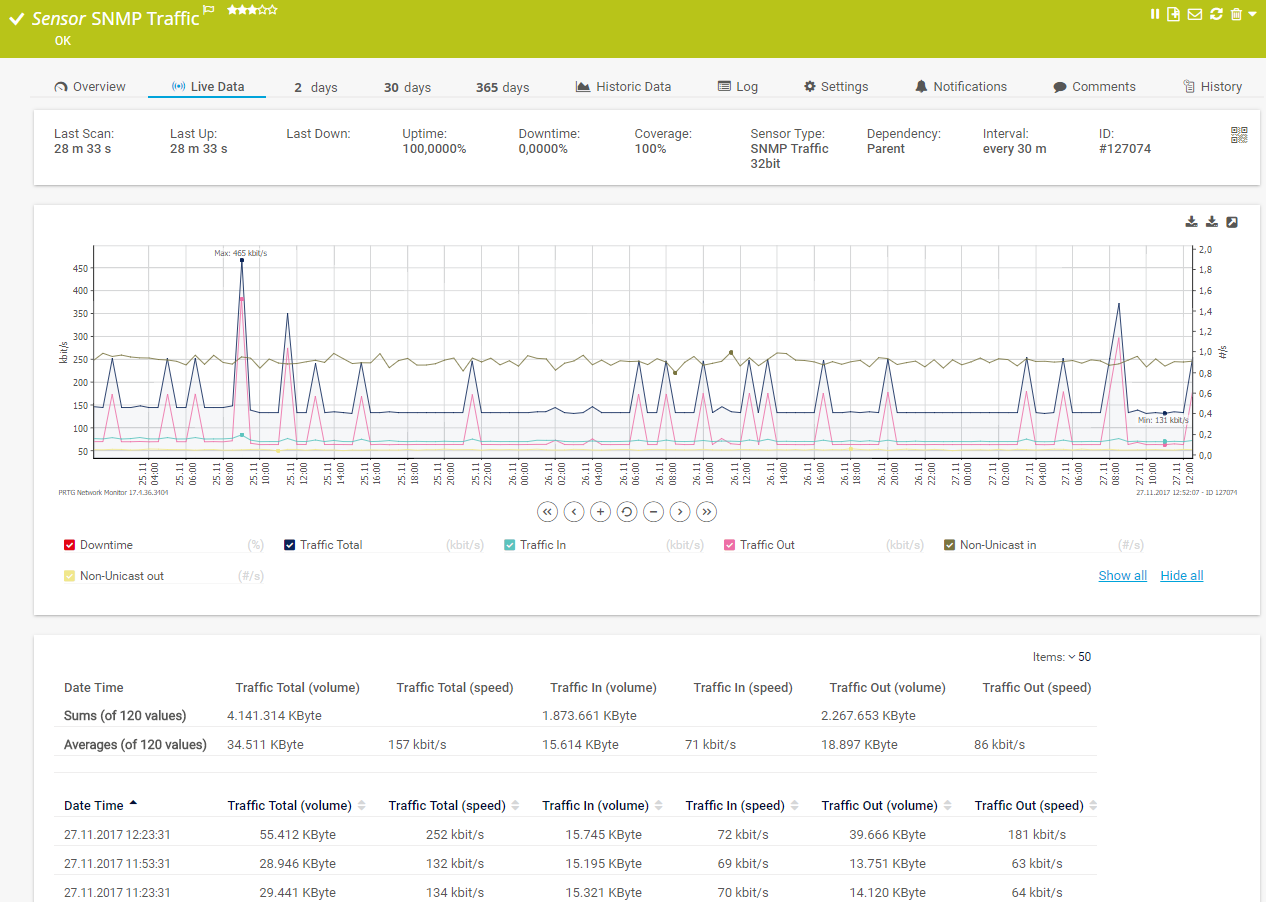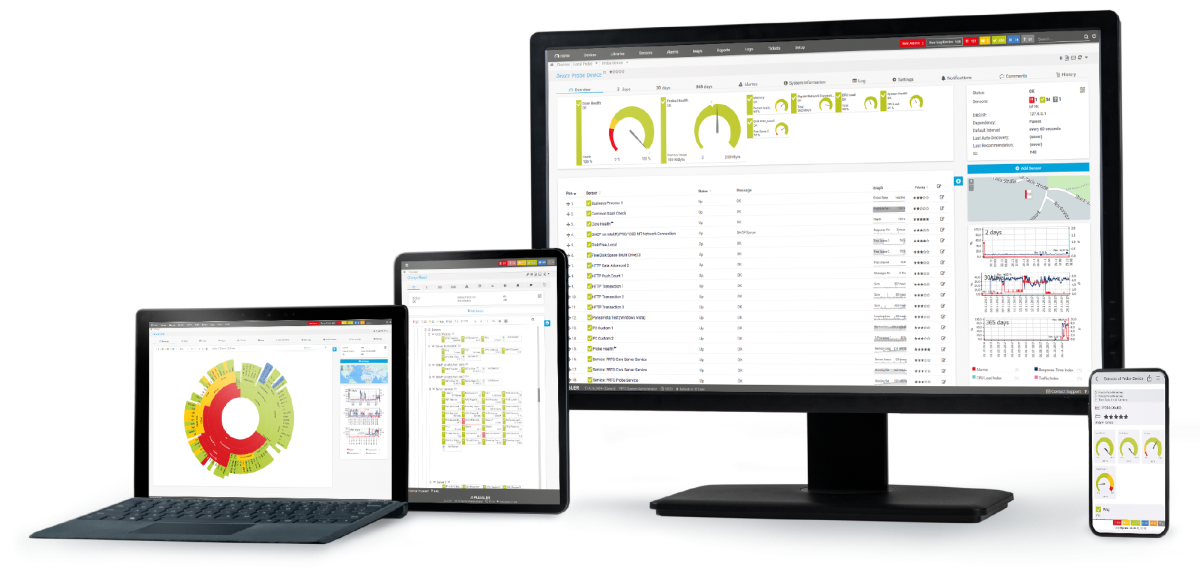Custom alerts and data visualization let you quickly identify and prevent resource bottlenecks, vulnerabilities, and other network issues.
If your doors are stuck, the simple act of leaving one room and entering another can feel like an intense gym workout. And if they don't close properly, there's a risk anyone could come in. Even people who aren't welcome in your home.
Paessler PRTG is your comprehensive network port scanner for tracking all your UDP and TCP ports' key stats and alerting you promptly when they aren't working as they should. That means it's easier to clear the way if there are bottlenecks, and make sure those you want to keep out of your network stay out.
Network health issues don't take days off. And neither does PRTG. Our port scanner monitors your network devices round the clock, continuously checking the status of all ports and determining whether a port is open, closed, or hidden.
With so much on your plate, potentially critical security issues can easily go unnoticed. PRTG open port checker keeps a close eye on switch ports, router ports, server ports, and other network infrastructure, rooting out weak spots before bad actors can exploit them.
Pick your preferred warning and error thresholds, and PRTG will ping you as soon as any of your network's ports are at risk of going under or over, so you can fix issues, and avoid security incidents and network disruption without breaking a sweat.
Diagnose network issues by continuously tracking ports across your network. Show port status, data transfer speed, and other key stats in real time. Visualize monitoring data in clear graphs and dashboards to identify problems more easily. Gain the overview you need to troubleshoot speed issues, security vulnerabilities, and other port problems.

Device tree view of the complete monitoring setup

Custom PRTG dashboard for keeping an eye on the entire IT infrastructure

Live traffic data graph in PRTG
PRTG comes with more than 250 native sensor types for monitoring your entire on-premises, cloud, and hybrid cloud environment out of the box. Check out some examples below!
See the PRTG Manual for a list of all available sensor types.
Custom alerts and data visualization let you quickly identify and prevent resource bottlenecks, vulnerabilities, and other network issues.
PRTG is set up in a matter of minutes and can be used on a wide variety of mobile devices.

“Excellent tool for detailed monitoring. Alarms and notifications work greatly. Equipment addition is straight forward and server initial setup is very easy. ...feel safe to purchase it if you intend to monitor a large networking landscape.”
Partnering with innovative IT vendors, Paessler unleashes synergies to create
new and additional benefits for joined customers.
By integrating PRTG with Martello iQ, you can add a fast analytics layer to improve uptime, visualize your IT environment, and integrate all of your IT systems into a single pane of glass.
Paessler and Plixer provide a complete solution adding flow and metadata analysis to a powerful network monitoring tool.
Siemon and Paessler bring together intelligent building technology and advanced monitoring and make your vision of intelligent buildings and data centers become reality.
Real-time notifications mean faster troubleshooting so that you can act before more serious issues occur.
Network Monitoring Software – Version 25.3.110.1313 (August 27, 2025)
Download for Windows and cloud-based version PRTG Hosted Monitor available
English, German, Spanish, French, Portuguese, Dutch, Russian, Japanese, and Simplified Chinese
Network devices, bandwidth, servers, applications, virtual environments, remote systems, IoT, and more
Choose the PRTG Network Monitor subscription that's best for you
Ports are endpoints that make it easier for all the different processes and services on your network to talk to each other. When ports are working as they should, data flows freely and your network runs smoothly. But when ports are misconfigured or have other issues, they can slow your network down and make you more vulnerable to trojans and other security risks.
Ports are part of a network address (IP address). They ensure TCP connections and data packets are assigned correctly and allow for the processing of services on the Internet. This may involve the transfer of files (ports 20 and 21) with the file transfer protocol (FTP), the sending of an email (port 25) via SMTP and IMAP, the SSH (Secure Shell) port 25, or the assignment of names to an IP address (Port 53) in a domain name system (DNS). Ports use a transport protocol to transmit information. Each port is assigned a non-random number. These port numbers range from 0 to 65535, with 1 to 1023 used for Internet protocols.
A transport protocol – aka a “network protocol” – specifies how data is to be exchanged between the components in a network. In other words, it defines the way in which data is transmitted. The two most common protocols are the Transmission Control Protocol (TCP) and the User Datagram Protocol (UDP). PRTG can be used as a port scanner for both TCP and UDP scans.
A port scanner is a tool that checks the status of ports. It uses queries to determine whether a port is open, closed, or hidden.
Some port scanners also scan open ports for additional information (such as the operating system in use), but this is not their primary purpose.
Port scanners work in a variety of ways. The simplest (and most common) way involves the uninterrupted transfer of data to a specific host. The port scanner notifies the system as soon as a data packet reaches an open port. Data packet types can also vary: TCP, UPD, ICMP, FIN, and ACK are just a few examples.
Port scanners can scan both vertically and horizontally. With vertical scans, a single network address is scanned on multiple ports. Horizontal scans, on the other hand, test several network addresses on a specific port (e.g., port 80).
Port monitoring is like surveillance, while port scanning is an inspection. A port monitoring tool helps you track overall performance and identify long-term trends. A port scanner, on the other hand, is how you spot potentially imminent threats, such as ports that are open when they should be closed.
PRTG port scanner regularly sends network requests to your chosen port and tracks how long it takes for the port to receive it. This enables it to identify whether the port is open or closed, and what devices, applications, or other services it's being used for.
PRTG is designed to scan ports using TCP. But you can also scan ports using UDP by creating a custom script.
In PRTG, “sensors” are the basic monitoring elements. One sensor usually monitors one measured value in your network, for example the traffic of a switch port, the CPU load of a server, or the free space on a disk drive. On average, you need about 5-10 sensors per device or one sensor per switch port.
Paessler conducted trials in over 600 IT departments worldwide to tune its network monitoring software closer to the needs of sysadmins. The result of the survey: over 95% of the participants would recommend PRTG – or already have.
Paessler PRTG is used by companies of all sizes. Sysadmins love PRTG because it makes their job a whole lot easier.
Bandwidth, servers, virtual environments, websites, VoIP services – PRTG keeps an eye on your entire network.
Everyone has different monitoring needs. That’s why we let you try PRTG for free.